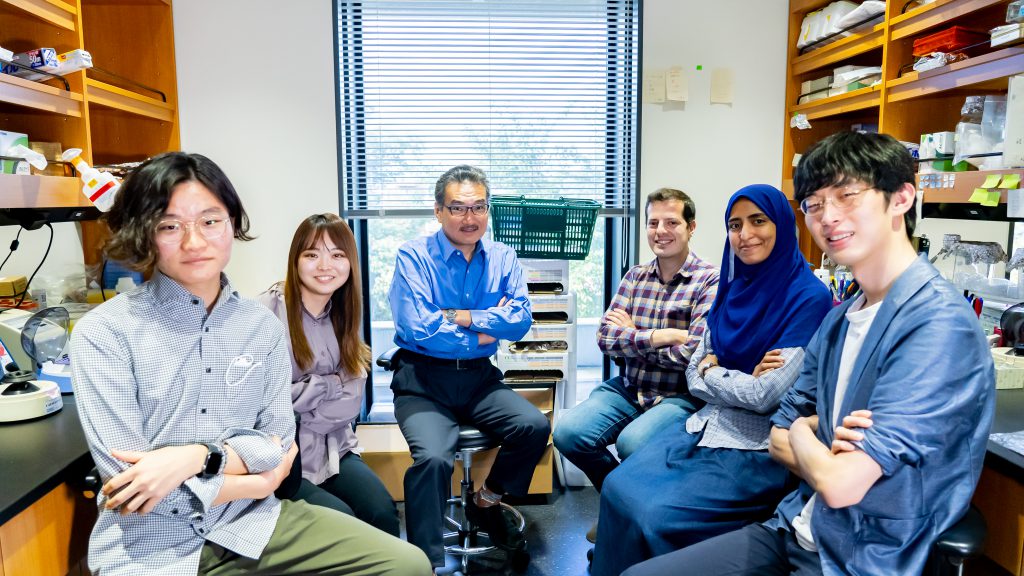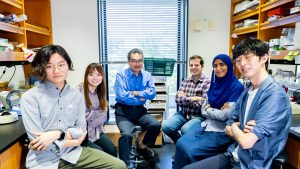
1985年 筑波大学医学専門学群 卒業
1988年 筑波大学大学院博士課程 修了
1989年 筑波大学基礎医学系薬理学講座 講師
1991年 京都大学医学部薬理学第一講座 講師
1991年 テキサス大学サウスウェスタン医学センター 准教授
1991年 ハワード・ヒューズ医学研究所 准研究員
1996年 テキサス大学サウスウェスタン医学センター 教授
1996年 ハワード・ヒューズ医学研究所 研究員
2001年 ERATO 柳沢オーファン受容体プロジェクト 責任者
2010年 筑波大学分子行動科学研究コア教授 FIRSTプログラム中心研究者
2012年 WPI 国際統合睡眠医科学研究機構 機構長
2014年 テキサス大学サウスウェスタン医学センター 客員教授
In 1988, Masashi Yanagisawa discovered endothelin, a peptide with potent vasoconstrictor activity. Ten years later, he discovered orexin, a novel neuropeptide expressed exclusively in the lateral hypothalamus. The following year, he reported that orexin-deficient mice exhibit narcolepsy-like sleep abnormalities. It is now clear that the pathology of narcolepsy is caused by orexin deficiency. Yanagisawa also succeeded in identifying QRFP as an endogenous ligand for GPR103, and NPB/W as an endogenous ligand for GPR7.
Over ten years of orexin research has convinced Yanagisawa that his team have to boldly take new approaches to gain fundamental insights on the mechanism of sleep/wake regulation. In 2009, he carried out a large-scale EEG/EMG-based forward genetic screen in a mutagenized cohort of mice, looking for new genes directly, which led to the identification of several novel sleep-regulating genes such as SIK3, NALCN, HDAC4, CACNA1A.
Their approaches include real-time visualization and manipulation of the activity of multiple neurons within the sleep/wake regulatory circuits in freely behaving mice.
In a translational front, they aim at discovering and developing orexin receptor agonists in order to treat narcolepsy and other conditions associated with excessive sleepiness.
1988年柳沢正史は強力な血管収縮作用を持つペプチド、エンドセリンを発見した。その10年後、視床下部外側野に限局して発現する新規神経ペプチド、オレキシンを発見した。その翌年オレキシン欠損マウスがナルコレプシー様の睡眠異常を示すことを報告した。現在ではナルコレプシーの病態がオレキシン欠損症であることが明らかになっている。柳沢はオーファンGPCRであったGPR103の内在性リガンドしてQRFPを、GPR7の内因性リガンドとしてNPB/Wの同定にも成功した。
柳沢は、10年以上にわたるオレキシンの研究から、睡眠・覚醒の調節機構に関する基本的な知見を得るためには、新しいアプローチを大胆にとらなければならないと確信した。2009年に、点突然変異を誘導させたマウスを用いて、脳波をベースにした大規模なフォワード・ジェネティック スクリーニングを行い、新規の遺伝子を直接探索した。その結果、SIK3、NALCN、HDAC4、CACNA1Aなど、いくつかの新規の睡眠制御遺伝子を同定することができた。
同時に、自由睡眠覚醒下や自由行動下でのマウスの睡眠覚醒制御ニューロンの可視化と操作も行っている。
トランスレーショナルな面では、ナルコレプシーをはじめとする過剰な眠気を伴う疾患の治療のために、オレキシン受容体アゴニストの開発を進めている。
Awards
2023 BreakThrough Prize
2019 文化功労者顕彰
2018 慶應医学賞
2018 朝日賞
2017 ベルツ賞
2016 紫綬褒章
2015 Walter B. Cannon Memorial Award American Physiological Society
2013 高峰譲吉賞 日本心血管内分泌代謝学会
2006 Outstanding Scientific Achievement Award Sleep Research Society
2003 Bristol-Myers Squibb Achievement Award in Cardiovascular Research
2001 Special Recognition Award Sleep Research Society
2001 The Jacobæus Prize Novo Nordisk Foundation
2000 塚原仲晃記念賞 ブレインサイエンス振興財団
1999 Amgen Award American Society of Biochemistry and Molecular Biology
1998 J.J.Abel Award American Society of Pharmacology and Experimental Therapeutics
1998 Medical Research Award Robert J. and Claire Pasarow Foundation
1998 Novartis Award American Heart Association
1998 Kilby Award Kilby Awards International Awards Foundation


1985年 筑波大学医学専門学群 卒業
1988年 筑波大学大学院博士課程 修了
1989年 筑波大学基礎医学系薬理学講座 講師
1991年 京都大学医学部薬理学第一講座 講師
1991年 テキサス大学サウスウェスタン医学センター 准教授
1991年 ハワード・ヒューズ医学研究所 准研究員
1996年 テキサス大学サウスウェスタン医学センター 教授
1996年 ハワード・ヒューズ医学研究所 研究員
2001年 ERATO 柳沢オーファン受容体プロジェクト 責任者
2010年 筑波大学分子行動科学研究コア教授 FIRSTプログラム中心研究者
2012年 WPI 国際統合睡眠医科学研究機構 機構長
2014年 テキサス大学サウスウェスタン医学センター 客員教授
In 1988, Masashi Yanagisawa discovered endothelin, a peptide with potent vasoconstrictor activity. Ten years later, he discovered orexin, a novel neuropeptide expressed exclusively in the lateral hypothalamus. The following year, he reported that orexin-deficient mice exhibit narcolepsy-like sleep abnormalities. It is now clear that the pathology of narcolepsy is caused by orexin deficiency. Yanagisawa also succeeded in identifying QRFP as an endogenous ligand for GPR103, and NPB/W as an endogenous ligand for GPR7.
Over ten years of orexin research has convinced Yanagisawa that his team have to boldly take new approaches to gain fundamental insights on the mechanism of sleep/wake regulation. In 2009, he carried out a large-scale EEG/EMG-based forward genetic screen in a mutagenized cohort of mice, looking for new genes directly, which led to the identification of several novel sleep-regulating genes such as SIK3, NALCN, HDAC4, CACNA1A.
Their approaches include real-time visualization and manipulation of the activity of multiple neurons within the sleep/wake regulatory circuits in freely behaving mice.
In a translational front, they aim at discovering and developing orexin receptor agonists in order to treat narcolepsy and other conditions associated with excessive sleepiness.
1988年柳沢正史は強力な血管収縮作用を持つペプチド、エンドセリンを発見した。その10年後、視床下部外側野に限局して発現する新規神経ペプチド、オレキシンを発見した。その翌年オレキシン欠損マウスがナルコレプシー様の睡眠異常を示すことを報告した。現在ではナルコレプシーの病態がオレキシン欠損症であることが明らかになっている。柳沢はオーファンGPCRであったGPR103の内在性リガンドしてQRFPを、GPR7の内因性リガンドとしてNPB/Wの同定にも成功した。
柳沢は、10年以上にわたるオレキシンの研究から、睡眠・覚醒の調節機構に関する基本的な知見を得るためには、新しいアプローチを大胆にとらなければならないと確信した。2009年に、点突然変異を誘導させたマウスを用いて、脳波をベースにした大規模なフォワード・ジェネティック スクリーニングを行い、新規の遺伝子を直接探索した。その結果、SIK3、NALCN、HDAC4、CACNA1Aなど、いくつかの新規の睡眠制御遺伝子を同定することができた。
同時に、自由睡眠覚醒下や自由行動下でのマウスの睡眠覚醒制御ニューロンの可視化と操作も行っている。
トランスレーショナルな面では、ナルコレプシーをはじめとする過剰な眠気を伴う疾患の治療のために、オレキシン受容体アゴニストの開発を進めている。
Awards
2023 BreakThrough Prize
2019 文化功労者顕彰
2018 慶應医学賞
2018 朝日賞
2017 ベルツ賞
2016 紫綬褒章
2015 Walter B. Cannon Memorial Award American Physiological Society
2013 高峰譲吉賞 日本心血管内分泌代謝学会
2006 Outstanding Scientific Achievement Award Sleep Research Society
2003 Bristol-Myers Squibb Achievement Award in Cardiovascular Research
2001 Special Recognition Award Sleep Research Society
2001 The Jacobæus Prize Novo Nordisk Foundation
2000 塚原仲晃記念賞 ブレインサイエンス振興財団
1999 Amgen Award American Society of Biochemistry and Molecular Biology
1998 J.J.Abel Award American Society of Pharmacology and Experimental Therapeutics
1998 Medical Research Award Robert J. and Claire Pasarow Foundation
1998 Novartis Award American Heart Association
1998 Kilby Award Kilby Awards International Awards Foundation

